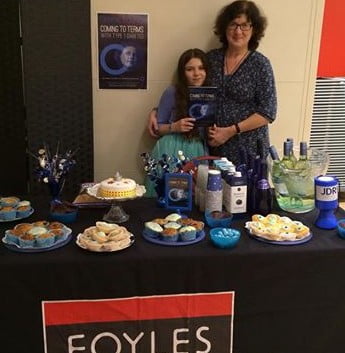Here's a handy tip for indie authors based outside of the US who are managing the production of self-published print books via Amazon's CreateSpace service. US-based authors might like to read it anyway as an example of how lateral thinking can help you bypass problems in your self-publishing career.
 During an earlier career in journalism, working on a monthly magazine, I acquired the habit of working to tight deadlines. I have a sign over my desk saying “Nothing makes me more productive than the last minute.” That attitude is fine when you are in sole control of what you are producing, as in writing an article or news report, and I naively assumed that the same would apply to self-publishing.
During an earlier career in journalism, working on a monthly magazine, I acquired the habit of working to tight deadlines. I have a sign over my desk saying “Nothing makes me more productive than the last minute.” That attitude is fine when you are in sole control of what you are producing, as in writing an article or news report, and I naively assumed that the same would apply to self-publishing.
Stumbling at the Last Hurdle
I was therefore horrified to discover, close to my self-imposed deadline for self-publishing a new paperback via CreateSpace, that the process would grind to a halt until I received my proof copy from the USA. Being based in the UK, this was going to be a surprisingly slow and costly process. This is because the proof copies are always printed in the US, even though any UK orders for the book post-publication would be printed and despatched from within the UK.
- If I were to order a proof today, for example, on 14th May, paying the standard delivery charge of $6.77 would deliver my book a month and a half later – estimated delivery date 1 July.
- Paying just a little more ($9.99) for the “expedited” service would bring it forward to a more acceptable 29 May.
- Paying the “priority” charge of $17.77 would mean I'd have to wait only a week, until 20th May.
Even so, a week (plus an extra £12) was more than I had bargained or budgeted for – this was, after all, a fundraising book for a charity, required for a specific launch date (World Diabetes Day) and aiming at earning as much as possible for the cause, the JDRF diabetes research charity.
Saved by an ALLi Friend
Luckily, posting an SOS on ALLi's private Facebook forum (a members-only benefit) averted my crisis. Fellow author Sandra Schwab, based in Germany, and an early adopter of CreateSpace self-publishing, had already found a solution. She suggested simply hitting the “publish” button and instantly ordering a paperback as soon as the book appeared on sale in the Amazon online store. This normally happens within 24-48 hours, once it's been through Amazon's quality control service. That way, I could get a copy printed in the UK and despatched instantly, using whichever delivery option I preferred, to get it whenever I wanted.
Being a member of Amazon Prime, that delivery cost me nothing – and all I paid was the cover price of the book, part of which I'd get back later as royalties in any case – something that doesn't happen if you order at the lower “author's copy” price through the CreateSpace dashboard. If you're not a Prime subscriber, you'll still be able to get it post-free provided you order something else to make your order up to the minimum threshold for free delivery in your Amazon territory.
So that's what I did, and I saved myself days or weeks of waiting, plus the significant delivery costs from the USA.
Is It Worth It?
In subsequent discussions of this concept, other authors have pointed out that in the context of the overall budget of any new book, the cost of shipping a proof from the US is not really significant. If you've paid hundreds or thousands of pounds for third parties for services for structural editing, copy editing, proofreading, and cover design, that is true. Equally if it's a book that you're expecting to sell in large numbers online, where you're likely to get the optimum profit margin (as opposed to selling through a bricks-and-mortar bookshop), the sums I've mentioned are not worth worrying about. However, for self-published authors who are operating on a shoestring and need to minimise outgoings, such savings are worth bothering about.
By the way, if, on receipt of your printed proof, you identify corrections to be made, that's not a problem – just upload a corrected file, and the book will be taken off sale until the final proof has passed Amazon's quality control. There is a small risk that someone might buy it and criticise it before you get the chance to do that, but to be fair, you have ample opportunity to pick up and correct errors via the online proofing system before you're required to order the printed proof, so there should really be little or nothing that you need to fix by this stage.
Bonus Tip re Ingram Spark
Incidentally, if you're following the received wisdom to publish your paperbacks simultaneously with CreateSpace and Ingram Spark (see separate posts about that topic here and here if you're not familiar with that idea), here's another cost-saving tip: use CreateSpace as your sandbox to get your print book proofs perfect before you upload them to Ingram Spark. You can upload as many revised files as you like to CreateSpace for free, but you'll be charged (at the time of writing) to upload revised interiors or covers to Spark.
#Toptip to speed up #CreateSpace #selfpublishing process by @DebbieYoungBN Share on XOVER TO YOU
Do you have any lateral thinking gems that help you in your self-publishing process? Please feel free to share them via the comments box.








Hi there, Cool post. There is a challenge with your site with website internet explorer, would certainly check this specific? Web browser nonetheless will be the market place chief as well as a big aspect of others will abandon your own spectacular publishing therefore trouble.
Hello Debbie, thanks for your article, it is really helpful. I have a question, though. I find that the print quality of the CS books is inferior. They say it’s because my MS fonts are not a 100% black. I have no option on my apple to get that level of black quality and CS say they can’t do it for me. In the publishing process, this means that my images also reduce from 300dpi to less than 200dpi. Have you come across this problem?
Thanks,
Leni
The Netherlands.
Hi Leni. The usual complaint I hear is that the paper quality on CS is inferior to that of Ingram Spark’s or Lightnng Source – I don’t know about the font issue but that’s interesting. I also don’t use images in the book interior, only on the cover. Sorry not to be more helpful – maybe someone else can help?-
Living in Australia, this story is one of the reasons I avoid using Createspace, and use Lulu instead, who print their proof copies and published copies either in the country from where the book was ordered, if possible, or in a country nearby. I know they have print partners in the UK and in Melbourne, Australia. This keeps postage costs down too. The advice re. Ingram Spark is good as well, and Lulu is fine to develop the book as well, before uploading to IS – whose fees, in my opinion, are outrageous.
Thanks, Inge, for adding the Australian perspective, that’s really helpful. My understanding is that Ingram Spark is working on bringing its fees down or even removing them altogether long term, because that’s an obvious point of difference that can put indie authors off using them – and that’s why I only upload files to Ingram Spark once I’m 100% happy with my CreateSpace paperback!
[…] Source: Book Production: How to Speed up the Proofing System on Amazon […]
Are you doing this in addition to using the digital proof system? Using the digital proofer on Createspace (proof the PDF online) will find about 99% of the potential errors. So if you’re doing that, then you can be pretty sure that even if some random person happens to buy your book after you press “publish” that it’s almost certainly OK.
Yes, absolutely, Kevin – and I check the proof many times in different formats before I even get to the digital proof stage, e.g. printing out the ms after it comes back from my proofreader, sending it to my Kindle, and only upload it to CreateSpace when I can’t find anything wrong in those formats. So there really should be no errors or problems in the printed proof – it’s just a question of a “belt and braces” approach to be absolutely sure that the book is the best it can be before I release it into the world.
Always happy to help, Debbie. 🙂
Btw, if you pay expedited shipping for your proofs or author copies from CS, it doesn’t guarantee that you’ll really get your books that fast. One of my shipments got stuck in customs, and in the end, it took longer to arrive than a shipment for which I had paid the standard fare. For me, that was the point where I decided to just hit publish and order a (proof) copy directly through Amazon.
Oh my goodness, that’s awful, Sandy! I know that quite often things I’ve ordered from Amazon within the UK can arrive earlier than their anticipated date, and I’ve always thought they did that on purpose so that we’re always pleasantly surprised if things arrive early, but I hadn’t thought about the customs issue – crikey!
It’s even worse when it’s old books that get stuck in customs. I’m pretty certain that my Victorian PUNCH pocket books got damaged by customs officers, but of course, I had no way to prove this. Grrrrr!